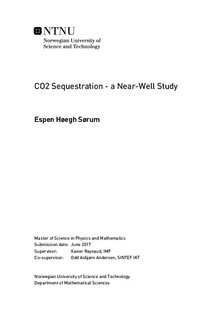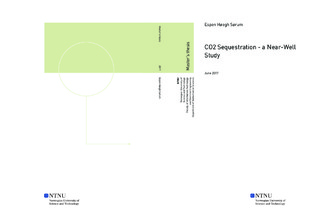| dc.description.abstract | Carbon Capture and Storage (CCS) has been proposed as a promising and necessary tool in strategies for mitigating the effects of anthropogenic climate change. Deep geological formations, like saline aquifers, are pointed out as promising areas for large-scale storage of CO2. To address questions relating to storage capacity and safety issues various computational models have been developed. A particularly useful modelling framework is the vertical-equilibrium (VE) model, which is based on the assumption of negligible vertical flow . Such a model is preferred when studying large-scale and long-term migration of CO2 in aquifers due to their computational efficiency.
However, the VE assumption leads to inaccurate solutions close to injecting wells, in so-called near-well areas. As the underlying VE assumption does not hold in these regions, flow here has to be modelled using a conventional 3D multi-phase approach, which poses a significantly higher computational demand. In order to bridge the gap between the VE and 3D modelling domains, a hybrid model has recently been proposed. In the hybrid model, the interface between the two domains is defined by a separation radius around injection wells. However, the optimal choice of this radius remains an open question. In the present work, the choice of radius is investigated using both a numerical and an analytical approach.
Using MRST, a free open-source simulation tool kit for reservoir modelling and simulation developed at SINTEF Digital, this thesis studies the conditions under which VE can be assumed in the near-well area and calculates the separation radius numerically. The separation radius can also be determined using an analytical solution for the height of the CO2 plume in a special injection scenario. Simulations with hybrid models are also conducted and compared to simulations from pure VE and 3D models.
Simulations herein indicates that the VE assumption is not valid for geological formations with low permeability (10 milliDarcy) and cubic relative permeability curves, as this leads to long drainage time of brine from the CO$_2$ plume. Results for both the numerical and analytical separation radius show that after a certain injection time VE can be assumed in the whole aquifer, i.e. the separation radius is zero. The numerical and analytical results show also some clear differences, despite efforts to ensure as small theoretical differences as possible.
The analytical solution tends to under-predict the region with negligible vertical flow compared with the numerical solution, whereas an overprediction would be more desirable from a practical point of view. Hence more research is needed before the analytical approach can be used for predicting the separation radius. Simulations with the hybrid model illustrates that they can significantly reduce computational requirements compared to a full 3D model, while preserving the accuracy of a full 3D solution close to the well in short-term simulations. More research and long-term simulations have to be conducted before any conclusions can be drawn of benefits and disadvantages of a hybrid model versus a pure VE model, which still is the preferred model for long-term simulations. | |

